Brie de Meaux
Brie de Meaux

Description
Paris offers the quintessential Brie de Meaux experience, with the world's most knowledgeable cheesemongers and finest selection. Being close to the production region, the capital boasts exceptional variety and freshness, from traditional fromageries to gourmet markets. Here, Brie de Meaux is treated with reverence as an important cultural heritage.
Dietary Information
Serving information
Serving style
In Parisian restaurants, presented on marble or wooden cheese boards, often with a dedicated cheese knife. Casual bistros may serve a single generous portion, while fine dining establishments offer a selection cut tableside from a cheese cart ('chariot de fromages').
Quick facts
Traditional fromageries typically open 9 AM - 7 PM Tuesday-Saturday, closed Sunday afternoon and Monday. Markets generally operate 8 AM - 1 PM, with days varying by location.
Safety Tips
What to Look For
-
Proper AOC/AOP certification
Authentic Brie de Meaux carries the Appellation d'Origine Protégée label, ensuring it adheres to traditional methods and quality standards.
-
Purchase from reputable cheese vendors with proper refrigeration
Specialty cheese shops ('fromageries') and legitimate market vendors with proper cold storage maintain the cheese at safe temperatures.
-
White, bloomy rind without extensive brown or dark spots
The rind should be predominantly white to ivory with perhaps slight reddish flecks. Extensive browning, black spots, or sliminess indicates improper aging or spoilage.
-
Mild ammonia smell that dissipates quickly
A slight ammonia scent is normal (especially as the cheese ripens) but should not be overwhelming or persistent when the cheese is aired out briefly.
-
Creaminess with structure
The cheese should be soft and yielding but maintain its shape when cut. Completely runny cheese may be overripe.
What to avoid
-
Brie with overwhelmingly strong ammonia odor
While some ammonia smell develops naturally as Brie ripens, an overwhelming or sharp ammonia odor indicates the cheese is overripe or improperly stored.
-
Discolored, cracked, or slimy rind
The rind should be relatively consistent in color. Extensive brown patches, black spots, sliminess, or unusual mold patterns suggest spoilage.
-
Pre-cut pieces with dried or darkened edges
Pre-cut Brie oxidizes quickly. Avoid pieces with hardened, discolored, or dry edges, as this indicates age or improper storage.
-
Cheese stored at room temperature for unknown periods
Although Brie should be served at room temperature, it should not be stored that way. Avoid vendors who display raw milk cheese unrefrigerated for extended periods.
-
Uniform texture throughout the entire cheese
Properly aged Brie should show progressive ripening from center to edge. Complete uniformity might indicate industrial production or improper aging.
Price information
Price range
Budget tips
- Purchase smaller portions (150-200g) rather than large wedges.
- Explore neighborhood markets like Marché Bastille rather than tourist-area shops.
- Fromageries sometimes offer slightly reduced prices for cheese nearing peak ripeness.
- Compare prices - even among quality vendors, prices can vary by 15-20%.
Value indicators
- AOC/AOP certification visible on label.
- Sold by a knowledgeable vendor who can discuss aging time.
- Hand-cut from a whole wheel rather than pre-packaged.
- Proper storage conditions in shop (refrigerated but not too cold).
- A reputable shop with 'Meilleur Ouvrier de France' certification.
Where to Find This Dish
Saint-Germain-des-Prés
Historic and upscale neighborhood with some of the city's most prestigious cheese shops.
Fromagerie Barthélemy, La Fromagerie, Marché Saint-Germain
Morning, Afternoon
Marais
Trendy area with both traditional fromageries and modern gourmet shops.
Laurent Dubois, Jouannault Fromager
Afternoon, Evening
Montmartre
Authentic neighborhood feel with good local cheese shops.
Fromagerie Lepic, Au Bon Fromage
Morning, Afternoon
Markets Throughout Paris
Weekly markets feature cheese specialists with excellent selections.
Marché d'Aligre, Marché Bastille, Marché President Wilson
Morning (8 AM - 1 PM), Early Afternoon (until they close)
Vendor Tips
- Ask for 'MOF' (Meilleur Ouvrier de France) certified cheesemongers who have exceptional expertise.
- Visit smaller neighborhood fromageries for more personal service and often better prices.
- Request cheese 'à point' (perfectly ripened) or specify how many days until you plan to eat it.
- Top Parisian cheese shops often allow tasting before purchase - don't hesitate to ask.
How to Order
Regional Variations
-
Artisanal Parisian Aging
(Affinage Parisien)
Some Parisian cheese shops age their own Brie de Meaux in special cellars beneath the city, creating unique flavor profiles unavailable elsewhere.
-
Market-Specific Selections
(Sélections de Marché)
Different Parisian markets are known for specific producers or aging styles, with some neighborhoods preferring younger, milder cheese and others favoring more robust, aged versions.
Cultural context
History
Dating back to the 8th century, Brie de Meaux has a prestigious history, even being crowned 'the King of Cheeses' at the 1815 Congress of Vienna. Legend suggests it was a favorite of Emperor Charlemagne. Traditional production methods have been preserved through the AOC designation established in 1980, which strictly governs geography, raw milk use, and aging requirements (minimum 4 weeks). Each wheel is hand-ladled into molds and turned several times during aging.
Local significance
In Paris, Brie de Meaux represents not just a cheese but a cultural institution. Parisians take pride in the proximity to its production region and the city's role in establishing its reputation globally. The cheese epitomizes the French concept of terroir and gastronomic excellence.
Eating customs
- Parisians typically eat the rind, considering it essential to the full experience.
- Usually paired with a crisp baguette tradition rather than fancy crackers.
- Often enjoyed with champagne or a wine from the Paris basin, like those from nearby Coteaux Champenois.
- In Paris, it's common to discuss the specific producer and affineur (cheese ager) as part of appreciating the cheese.